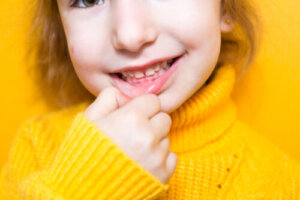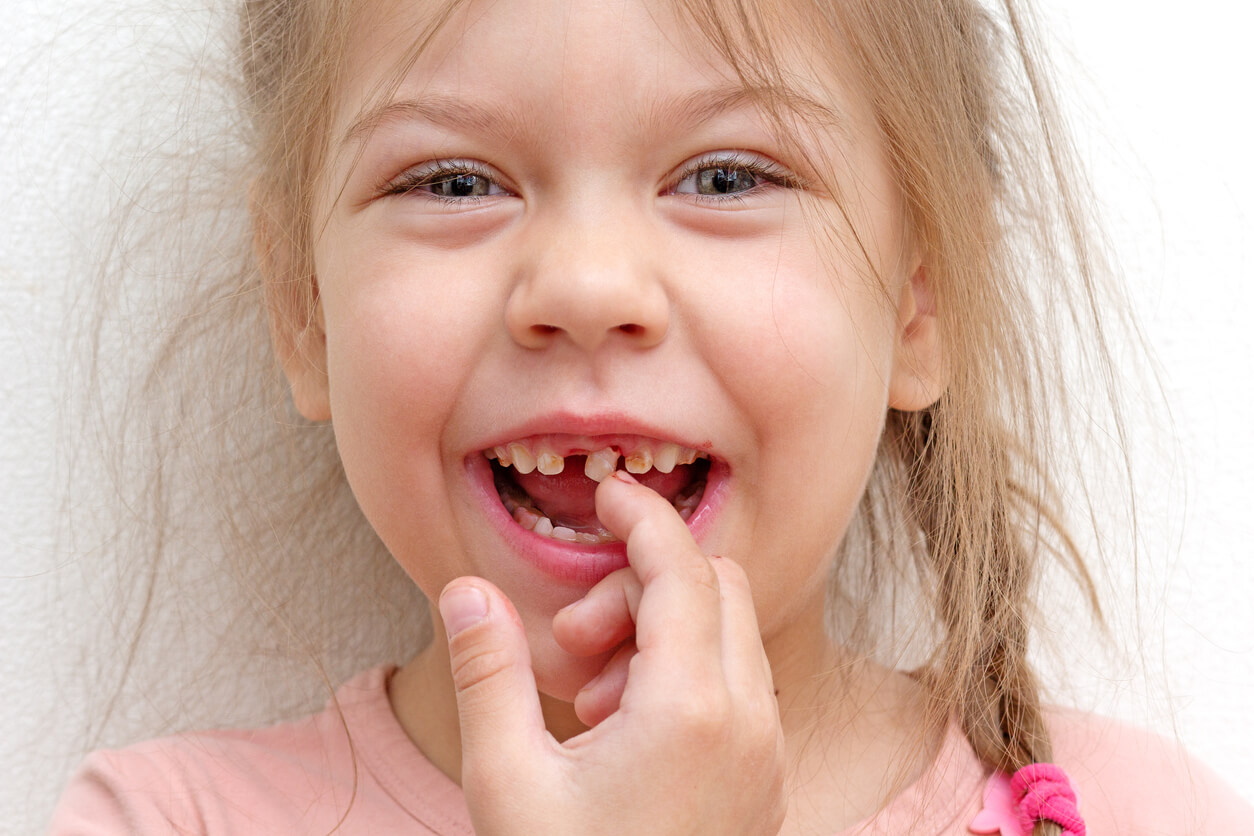How Baby Teeth Are Replaced by Permanent Teeth


Written and verified by the dentist Vanesa Evangelina Buffa
At some point in childhood, the first teeth will move, fall out, and a new element will take their place. In order for you to understand what happens inside your child’s mouth, we’ll tell you about the process through which permanent teeth replace baby teeth.
The stage in which the first teeth begin to move and fall out is very significant, both for the child and for their parents. Loose teeth, the moment they come out of the gum, and the visit of the tooth fairy mobilize the whole family. This childhood milestone is a demonstration of your child’s growth.
How do permanent teeth replace baby teeth?
Around the age of 6, the stage of tooth replacement begins. This process consists of the physiological falling out of the temporary teeth to be replaced by their definitive substitutes. This occurs gradually and culminates around the age of 12, with the replacement of the 20 deciduous teeth.
Baby teeth are too small and weak to fulfill the oral functions of an adult. Therefore, they’re replaced by larger and stronger ones that will accompany the person for the rest of their life. When the definitive elements are ready to erupt, they begin the process of replacement through specialized cells that reabsorb the roots of the baby teeth inside the bone.
The falling out of the baby teeth
When they lose the root that kept them attached to the arch, the temporary teeth begin to move. Thus, when there’s no support, the loose tooth falls out. From then on, the permanent element begins to appear in the empty space to take its place until it manages to get into its correct position.
You should know that permanent teeth are larger than baby teeth. For this reason, the spaces in the arch, typical of temporary teeth, disappear. In addition, it’s common for some permanent teeth to appear crooked. In general, as the jaw grows and the other elements begin to fall out, the new teeth manage to align themselves. In any case, it’s always advisable that the pediatric dentist supervises the process.

At what age and in what order do permanent teeth replace baby teeth?
The falling out and replacement of teeth depends to a greater extent on the growth rate of each child. Although it’s common for baby teeth to begin to loosen and fall out around 6 years of age, some children begin to replace them earlier and others much later.
Many factors can influence the timing of tooth replacement in children. Heredity, systemic problems, environmental causes, nutrition, hormones, or oral health are some examples. In any case, there’s an estimated age at which parents can expect tooth replacement to happen in their children. Namely:
- Central incisors: These are the first teeth to erupt. First, the lower ones appear around 6 years of age. Then the upper ones appear between 6 and 7 years of age.
- Lateral incisors: Once the central incisors have erupted, the lateral incisors are the next to be replaced. The upper ones loosen first and then the lower ones. This happens between 7 and 8 years of age.
- Temporary first molars: These fall out between the ages of 9 and 11. They have the particularity of being replaced by a definitive dental piece different from the one that comes out: The first premolars.
- Canines: These fall out between 9 and 12 years of age and are replaced by permanent canines.
- Temporary second molars: These are the last to fall out, between 10 and 12 years of age. They’re replaced by second premolars.
The definitive molars
As we already mentioned above, the definitive molars appear spontaneously in the back of the mouth, without replacing any baby teeth. These permanent teeth are located in the free space behind the temporary second molars. The eruption of the first permanent molar occurs at 6 years of age, the second at 12, and the third, also known as “wisdom teeth”, between 18 and 20 years of age. The lower molars usually erupt first, and then the upper ones.
As the child grows, their jaw widens and the permanent teeth are able to position themselves correctly. By the age of 13, most children have all 28 permanent teeth in their mouths. With the eruption of the third molars, the 32 pieces of the adult dentition are completed, which happens around the age of 18. However, wisdom teeth don’t erupt in everyone.

When to see a professional?
Ideally, the process of tooth replacement should be followed and monitored by a pediatric dentist. The professional is responsible for evaluating the growth of the jaws and detecting any problems early on. It’s not necessary to take the child to the dentist every time a tooth becomes loose. Checkups every 6 months from the first year of life are usually enough.
However, there are some situations that warrant consulting a pediatric dentist:
- Delayed tooth replacement: Each child follows their own rhythm, but if you notice that your little one doesn’t have any loose teeth, you can clarify the situation by consulting a professional.
- Crooked permanent teeth: Permanent teeth erupt where they can. When the jawbone grows, they usually fall into place on their own. In any case, it’s advisable to have the dentist evaluate the situation to see if stimulating bone growth is necessary.
- A double row of teeth: Sometimes the permanent teeth don’t manage to reabsorb the roots of the temporary teeth and erupt without the latter coming out. This situation causes a double row of teeth that the dentist must analyze. Many times, extracting the baby tooth is necessary.
- Premature tooth loss: Untreated cavities or a blow can lead to premature loss of the baby teeth. The dentist must intervene to save space for the permanent teeth and prevent malocclusions.
Taking care of the new permanent teeth
When the definitive teeth replace the baby teeth, it’s very important to take proper care of them in order to keep them healthy. These new teeth should be with you for life. Proper oral hygiene, a healthy diet, and regular visits to the pediatric dentist are essential to keep the new teeth healthy. With this basic care, you can accompany the process of replacing your children’s teeth responsibly.
At some point in childhood, the first teeth will move, fall out, and a new element will take their place. In order for you to understand what happens inside your child’s mouth, we’ll tell you about the process through which permanent teeth replace baby teeth.
The stage in which the first teeth begin to move and fall out is very significant, both for the child and for their parents. Loose teeth, the moment they come out of the gum, and the visit of the tooth fairy mobilize the whole family. This childhood milestone is a demonstration of your child’s growth.
How do permanent teeth replace baby teeth?
Around the age of 6, the stage of tooth replacement begins. This process consists of the physiological falling out of the temporary teeth to be replaced by their definitive substitutes. This occurs gradually and culminates around the age of 12, with the replacement of the 20 deciduous teeth.
Baby teeth are too small and weak to fulfill the oral functions of an adult. Therefore, they’re replaced by larger and stronger ones that will accompany the person for the rest of their life. When the definitive elements are ready to erupt, they begin the process of replacement through specialized cells that reabsorb the roots of the baby teeth inside the bone.
The falling out of the baby teeth
When they lose the root that kept them attached to the arch, the temporary teeth begin to move. Thus, when there’s no support, the loose tooth falls out. From then on, the permanent element begins to appear in the empty space to take its place until it manages to get into its correct position.
You should know that permanent teeth are larger than baby teeth. For this reason, the spaces in the arch, typical of temporary teeth, disappear. In addition, it’s common for some permanent teeth to appear crooked. In general, as the jaw grows and the other elements begin to fall out, the new teeth manage to align themselves. In any case, it’s always advisable that the pediatric dentist supervises the process.

At what age and in what order do permanent teeth replace baby teeth?
The falling out and replacement of teeth depends to a greater extent on the growth rate of each child. Although it’s common for baby teeth to begin to loosen and fall out around 6 years of age, some children begin to replace them earlier and others much later.
Many factors can influence the timing of tooth replacement in children. Heredity, systemic problems, environmental causes, nutrition, hormones, or oral health are some examples. In any case, there’s an estimated age at which parents can expect tooth replacement to happen in their children. Namely:
- Central incisors: These are the first teeth to erupt. First, the lower ones appear around 6 years of age. Then the upper ones appear between 6 and 7 years of age.
- Lateral incisors: Once the central incisors have erupted, the lateral incisors are the next to be replaced. The upper ones loosen first and then the lower ones. This happens between 7 and 8 years of age.
- Temporary first molars: These fall out between the ages of 9 and 11. They have the particularity of being replaced by a definitive dental piece different from the one that comes out: The first premolars.
- Canines: These fall out between 9 and 12 years of age and are replaced by permanent canines.
- Temporary second molars: These are the last to fall out, between 10 and 12 years of age. They’re replaced by second premolars.
The definitive molars
As we already mentioned above, the definitive molars appear spontaneously in the back of the mouth, without replacing any baby teeth. These permanent teeth are located in the free space behind the temporary second molars. The eruption of the first permanent molar occurs at 6 years of age, the second at 12, and the third, also known as “wisdom teeth”, between 18 and 20 years of age. The lower molars usually erupt first, and then the upper ones.
As the child grows, their jaw widens and the permanent teeth are able to position themselves correctly. By the age of 13, most children have all 28 permanent teeth in their mouths. With the eruption of the third molars, the 32 pieces of the adult dentition are completed, which happens around the age of 18. However, wisdom teeth don’t erupt in everyone.

When to see a professional?
Ideally, the process of tooth replacement should be followed and monitored by a pediatric dentist. The professional is responsible for evaluating the growth of the jaws and detecting any problems early on. It’s not necessary to take the child to the dentist every time a tooth becomes loose. Checkups every 6 months from the first year of life are usually enough.
However, there are some situations that warrant consulting a pediatric dentist:
- Delayed tooth replacement: Each child follows their own rhythm, but if you notice that your little one doesn’t have any loose teeth, you can clarify the situation by consulting a professional.
- Crooked permanent teeth: Permanent teeth erupt where they can. When the jawbone grows, they usually fall into place on their own. In any case, it’s advisable to have the dentist evaluate the situation to see if stimulating bone growth is necessary.
- A double row of teeth: Sometimes the permanent teeth don’t manage to reabsorb the roots of the temporary teeth and erupt without the latter coming out. This situation causes a double row of teeth that the dentist must analyze. Many times, extracting the baby tooth is necessary.
- Premature tooth loss: Untreated cavities or a blow can lead to premature loss of the baby teeth. The dentist must intervene to save space for the permanent teeth and prevent malocclusions.
Taking care of the new permanent teeth
When the definitive teeth replace the baby teeth, it’s very important to take proper care of them in order to keep them healthy. These new teeth should be with you for life. Proper oral hygiene, a healthy diet, and regular visits to the pediatric dentist are essential to keep the new teeth healthy. With this basic care, you can accompany the process of replacing your children’s teeth responsibly.
All cited sources were thoroughly reviewed by our team to ensure their quality, reliability, currency, and validity. The bibliography of this article was considered reliable and of academic or scientific accuracy.
- Estévez, M. R. (2015). CARACTERÍSTICAS DE LA ERUPCIÓN DENTARIA Y FACTORES QUE INFLUYEN EN EL ORDEN Y CRONOLOGIA. Escuela de Odontología de la Universidad de La Habana.
- Pérez Villa, G. K. (2021). Perdida prematura de dientes temporales en escolares (Bachelor’s thesis, Universidad de Guayaquil. Facultad Piloto de Odontología).
- Ayala Pérez, Y., Carralero Zaldívar, L. D. L. C., & Leyva Ayala, B. D. R. (2018). La erupción dentaria y sus factores influyentes. Correo Científico Médico, 22(4), 681-694.
- Torres, G. L., Ortiz, V. S., Hernández, M. N., & Briones, M. A. (2022). Factores que influyen en la cronología de erupción y su relación con las maloclusiones. Revista Científica Higía de la Salud, 6(1).
- Maduro Jácome, S. G. (2021). Factores que influyen en la erupción dentaria retardada (Bachelor’s thesis, Universidad de Guayaquil. Facultad Piloto de Odontología).
- Cuétara, L. H., Pupo, D. T. P., Queija, Y. F., & Pérez, I. L. (2022). Cronología y secuencia de erupción dentaria permanente en niños de 5 a 12 años. Salud, Ciencia y Tecnología, 1(1).
- De la Cruz Sedano, G. S., Flores, A. K. V., Porroa, J. J. J., & de Priego, G. A. P. M. (2020). Erupción dentaria: bases moleculares. Un artículo de revisión. Revista Científica Odontológica, 8(1), e009-e009.
- Cano, L. M., Cortés, M. P., & Pérez, M. D. (2022). Relación entre el nivel socioeconómico y la cronología y secuencia de erupción de la dentición permanente. Científica dental: Revista científica de formación continuada, 19(2), 49-56.
This text is provided for informational purposes only and does not replace consultation with a professional. If in doubt, consult your specialist.








